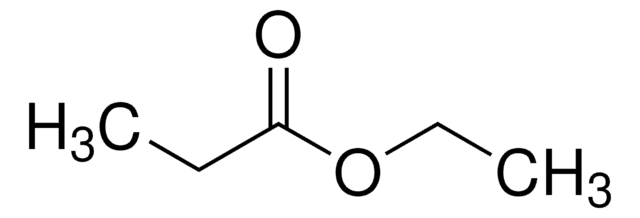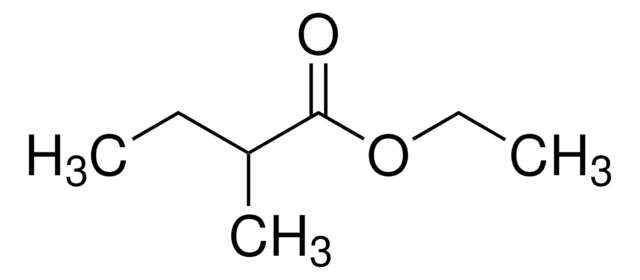148962
Ethyl hexanoate
≥99%
Synonym(s):
Caproic acid ethyl ester, Ethyl caproate
Sign Into View Organizational & Contract Pricing
All Photos(2)
About This Item
Linear Formula:
CH3(CH2)4COOC2H5
CAS Number:
Molecular Weight:
144.21
Beilstein:
1701293
EC Number:
MDL number:
UNSPSC Code:
12352100
PubChem Substance ID:
NACRES:
NA.22
Recommended Products
vapor density
5 (vs air)
Quality Level
Assay
≥99%
form
liquid
refractive index
n20/D 1.407 (lit.)
bp
168 °C (lit.)
density
0.869 g/mL at 25 °C (lit.)
SMILES string
CCCCCC(=O)OCC
InChI
1S/C8H16O2/c1-3-5-6-7-8(9)10-4-2/h3-7H2,1-2H3
InChI key
SHZIWNPUGXLXDT-UHFFFAOYSA-N
Looking for similar products? Visit Product Comparison Guide
General description
Ethyl hexanoate is one of the odorants contributing to the typical guava aroma. It also contributes to the fresh strawberry aroma.
Signal Word
Warning
Hazard Statements
Precautionary Statements
Hazard Classifications
Flam. Liq. 3
Storage Class Code
3 - Flammable liquids
WGK
WGK 1
Flash Point(F)
127.4 °F - closed cup
Flash Point(C)
53 °C - closed cup
Personal Protective Equipment
dust mask type N95 (US), Eyeshields, Gloves
Choose from one of the most recent versions:
Already Own This Product?
Find documentation for the products that you have recently purchased in the Document Library.
Customers Also Viewed
Jorge A Pino et al.
Journal of the science of food and agriculture, 93(12), 3114-3120 (2013-04-05)
Solid phase microextraction and simultaneous distillation-extraction combined with GC-FID, GC/MS, aroma extract dilution analysis and odour activity values were used to analyse volatile compounds from guava (Psidium guajava L. cv. Red Suprema) and to estimate the most odour-active compounds. The
Yong-Hyun Kim et al.
Sensors (Basel, Switzerland), 13(6), 7939-7978 (2013-06-22)
The classes and concentrations of volatile organic compounds (VOC) released from fresh and decaying strawberries were investigated and compared. In this study, a total of 147 strawberry volatiles were quantified before and after nine days of storage to explore differences
Alexandre Juteau et al.
Journal of agricultural and food chemistry, 52(6), 1621-1629 (2004-03-20)
Release of aroma compounds in selected iota-carrageenan systems was studied by static headspace analysis. By varying the sodium chloride content, different rheological behaviors were obtained ranging from solution to gel. From the release curves, mass transfer (h(D)) and partition coefficients
Dong Wang et al.
Bioprocess and biosystems engineering, 30(3), 147-155 (2007-01-26)
The cell-bound lipase from Rhizopus chinensis CCTCC M201021 with high catalysis ability for ester synthesis was located as a membrane-bound lipase by the treatments of Yatalase firstly. In order to improve its synthetic activity in non-aqueous phase, the pretreatments of
J C Bohlscheid et al.
Journal of applied microbiology, 102(2), 390-400 (2007-01-24)
To study the impact of assimilable nitrogen, biotin and their interaction on growth, fermentation rate and volatile formation by Saccharomyces. Fermentations of synthetic grape juice media were conducted in a factorial design with yeast assimilable nitrogen (YAN) (60 or 250
Our team of scientists has experience in all areas of research including Life Science, Material Science, Chemical Synthesis, Chromatography, Analytical and many others.
Contact Technical Service












